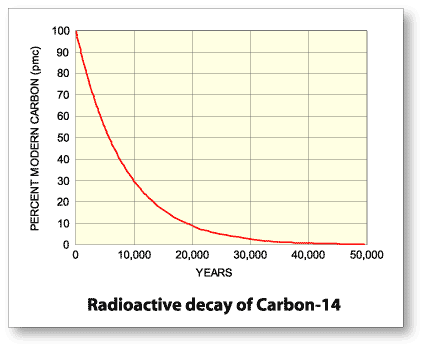

 during the
mid-1960's as a result of the atmospheric testing of thermonuclear
weapons (Clark and Fritz, 1997). 14C activities are
expressed as a percent of modern carbon (pmc). With a half-life
of 5,568 years, 14C is useful for dating ground water
that is between 1,000 and 30,000 years old (Coplen, 1993). Diffusion
and geochemical reactions within an aquifer, however, can alter
the 14C activity. Isotopic adjustment models within a geochemical reaction path model
(Plummer and others, 1983; 1991; 1994) are used to account for
dilution and addition of carbon along ground-water flowpaths,
which improves the accuracy of age determinations.
during the
mid-1960's as a result of the atmospheric testing of thermonuclear
weapons (Clark and Fritz, 1997). 14C activities are
expressed as a percent of modern carbon (pmc). With a half-life
of 5,568 years, 14C is useful for dating ground water
that is between 1,000 and 30,000 years old (Coplen, 1993). Diffusion
and geochemical reactions within an aquifer, however, can alter
the 14C activity. Isotopic adjustment models within a geochemical reaction path model
(Plummer and others, 1983; 1991; 1994) are used to account for
dilution and addition of carbon along ground-water flowpaths,
which improves the accuracy of age determinations.Bradley, R.S., 1985, Quaternary paleoclimatology: Boston, Unwin Hyman, 472 p.
Clark, I.D., and Fritz, Peter, 1997, Environmental isotopes in hydrogeology: New York, Lewis Publishers, 328 p.
Coplen, T.B., 1993, Uses of environmental isotopes, in W.M. Alley, ed., Regional ground-water quality: New York, Van Nostrand Reinhold, p. 227-254.
Plummer, L.N., Parkhurst, D.L., and Thirstiness, D.C., 1983, Development of reaction models for ground-water systems: Geochimica et Cosmochimica Acta, v. 47, p. 665-686.
Plummer, L.N., Prestemon, E.C., and Parkhurst, D.L., 1991, An interactive code (NETPATH) for modeling net geochemical reactions along a flow path: 91-4078, 227 p.
______1994, An interactive code (NETPATH) for modeling net geochemical reactions along a flow path, version 2.0: 94-4169, 130 p.

